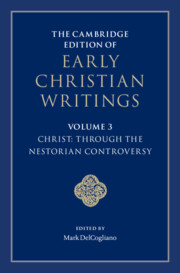Book contents
- The Cambridge Edition of Early Christian Writings
- The Cambridge Edition of Early Christian Writings
- The Cambridge Edition of Early Christian Writings
- Copyright page
- Contents
- Notes on Contributors
- Acknowledgments
- Note on the Texts and Translations
- Abbreviations
- Series Introduction
- Introduction
- Part I The Beginnings of Christology
- Part II Developing Christological Traditions
- Part III Traditions of Pro-Nicene Christology
- Part IV Controversy over Nestorius
- 40 Eusebius of Dorylaeum, Protest
- 41 Cyril of Alexandria, Second Letter to Nestorius
- 42 Nestorius of Constantinople, Second Letter to Cyril
- 43 Proclus of Constantinople, Homily on the Holy Virgin Theotokos
- 44 Nestorius of Constantinople, Three Letters to Celestine of Rome
- 45 John Cassian, On the Incarnation of the Lord against Nestorius 3.1–16 and 5.1–4
- 46 Cyril of Alexandria, Third Letter to Nestorius
- 47 Nestorius of Constantinople, Letter to John of Antioch
- 48 Theodoret of Cyrrhus, Refutation of the Twelve Anathemas of Cyril of Alexandria
- 49 Acts of the Council of Ephesus ( June–October 431): Selected Proceedings
- 50 Cyril of Alexandria, Letter of Reunion to John of Antioch
- 51 Ibas of Edessa, Letter to Mari the Persian
- 52 Cyril of Alexandria, First Letter to Succensus
- 53 Cyril of Alexandria, Second Letter to Succensus
- 54 Theodoret of Cyrrhus, Eranistes: Epilogue
- Suggestions for Further Reading
- Scriptural Index
43 - Proclus of Constantinople, Homily on the Holy Virgin Theotokos
from Part IV - Controversy over Nestorius
Published online by Cambridge University Press: 05 February 2022
- The Cambridge Edition of Early Christian Writings
- The Cambridge Edition of Early Christian Writings
- The Cambridge Edition of Early Christian Writings
- Copyright page
- Contents
- Notes on Contributors
- Acknowledgments
- Note on the Texts and Translations
- Abbreviations
- Series Introduction
- Introduction
- Part I The Beginnings of Christology
- Part II Developing Christological Traditions
- Part III Traditions of Pro-Nicene Christology
- Part IV Controversy over Nestorius
- 40 Eusebius of Dorylaeum, Protest
- 41 Cyril of Alexandria, Second Letter to Nestorius
- 42 Nestorius of Constantinople, Second Letter to Cyril
- 43 Proclus of Constantinople, Homily on the Holy Virgin Theotokos
- 44 Nestorius of Constantinople, Three Letters to Celestine of Rome
- 45 John Cassian, On the Incarnation of the Lord against Nestorius 3.1–16 and 5.1–4
- 46 Cyril of Alexandria, Third Letter to Nestorius
- 47 Nestorius of Constantinople, Letter to John of Antioch
- 48 Theodoret of Cyrrhus, Refutation of the Twelve Anathemas of Cyril of Alexandria
- 49 Acts of the Council of Ephesus ( June–October 431): Selected Proceedings
- 50 Cyril of Alexandria, Letter of Reunion to John of Antioch
- 51 Ibas of Edessa, Letter to Mari the Persian
- 52 Cyril of Alexandria, First Letter to Succensus
- 53 Cyril of Alexandria, Second Letter to Succensus
- 54 Theodoret of Cyrrhus, Eranistes: Epilogue
- Suggestions for Further Reading
- Scriptural Index
Summary
A gem of early Christian oratory, Proclus’s first homily on the Holy Virgin draws on the emerging tradition of festal homilies such as we see in Basil of Caesarea’s Homily on the Holy Birth of Christ and Gregory of Nyssa’s Homily on the Savior’s Nativity1 and addresses the crises of his day. Proclus was bishop of Cyzicus in 430 when he proclaimed this homily in the presence of his archbishop, Nestorius, who had been installed by Theodosius II on the episcopal throne in Constantinople. The occasion, it appears, was the feast of the Virgin that had recently been instituted in Constantinople for December 26. Defying Nestorius, Proclus unequivocally defends the language of Mary as Theotokos, which for him safeguards what he calls here the “coupling of natures,” divine and human, in Christ, the “incarnate God.” To name Mary’s role in effecting this union, Proclus draws on a trove of imagery at once exuberant and focused. Mary is, following the Cappadocians, the incarnation’s “workshop,” but also a bridge, a field, and a temple.
- Type
- Chapter
- Information
- The Cambridge Edition of Early Christian Writings , pp. 577 - 584Publisher: Cambridge University PressPrint publication year: 2022



